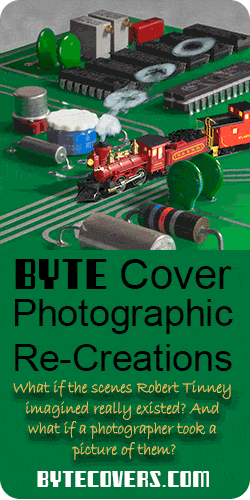 |
 |
What if the beautiful, surreal paintings that graced the covers of Byte magazine were not merely figments of Robert Tinney’s imagination, but existed in real life? And what if someone photographed them?
That was my idea three years ago, when I re-created Robert Tinney’s “Computer Engineering” as a photograph. Now, I’ve done the same with another of his paintings, “Chip Building”.
(Mr. Tinney has given me permission to sell my photos. You can visit my store at bytecovers.galacticstudios.org.)
The date was January, 1979, and Byte magazine’s feature article was about the design of the Motorola 6809 microprocessor. Because of this article, I chose the 6809 as the core of the first computer I owned. The cover of the magazine showed a man using a jackhammer to chisel out an integrated circuit.
I started my photography project by buying a 6809 from eBay and de-capping it. De-capping a chip can be done with boiling fuming nitric acid. The word “acid” is scary enough, but each of those adjectives makes it even scarier. I opted to pay a company to de-cap it for me. The company I used has since gone out of business, but here’s another that provides the service.
(I actually had two chips de-capped: the 6809 and a modern 32 bit microcontroller, the PIC32. Under lights, the 6809 looks mostly gray while the PIC32 refracts the light into a wide variety of colors. It was so pretty that I was tempted to use the PIC32 instead of the 6809 for my photo, but I restrained myself because 1) it was less faithful to the original painting and 2) bright colors did not fit the concept of chiseling a circuit out of concrete.)
The rest was pretty straightforward: I photographed the chip with a macro lens, rented a jackhammer and photographed myself with it, photographed a piece of concrete, and composited all the pictures together in Photoshop.
In both this picture and my Computer Engineering picture, I struggled with matching the angles of Mr. Tinney’s original paintings. And, frankly, I failed. But I guess it makes sense that Mr. Tinney and the photographer would be sitting in different locations when they each captured this scene. That’s my story and I’m sticking to it.



Cool. The Tinney painting is obviously based on a real 6809. I’d love to see what the PIC32 looks like.
Well done.
They are both great! Maybe try this one next?
http://rwebs.net/micros/images/proctech/ssbfront.jpg